The New Dodge Charger Is Here: Daytona EV Coupe for 2024, Sedan and “Sixpack” Gas Model in 2025
America’s muscle car is entering a new era. This is the 2025 Dodge Charger. You may notice that this hulking two-door looks almost identical to the Charger SRT Daytona concept that broke cover in August 2022. That’s no accident—Dodge head honcho Tim Kuniskis made a conscious effort to put more or less the final design out in the open so it could marinate for 18 months in people’s minds. Now, the steak is ready to sizzle, and it’s coming in a few different cuts—electric, gas, two-door, and four-door.
Kuniskis projected deep confidence in the two new powertrains, which include a 100.5-kW battery with dual electric motors for the EV model and Stellantis’ new 3.0-liter twin-turbo inline-six for the gas model. “They told us we couldn’t sell Hemis,” Kuniskis said in a promotional video, shown to journalists at a Detroit location requested we keep secret, “but they never said they had to be boring and slow.”
Though there is no V-8 anywhere in the product plan, Kuniskis stands behind the new powertrains as a way “not to comply, but to compete.”
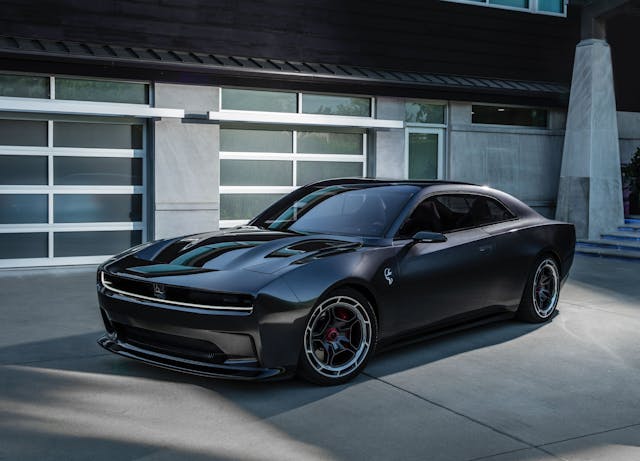

We had the chance to walk around and sit inside the new Charger coupe. It’s a great-looking machine with an imposing presence, differing from the concept car only in the side mirrors, door handles, B-pillar treatment, and wheels.
New Charger, New “Multienergy” Platform
Planned from the outset as both a pure EV and a traditional combustion-engine vehicle, the new Dodge Charger is the first-ever production model to use the STLA Large platform of parent company Stellantis. The platform supports both 400-volt and 800-volt architectures, with each electric drive module (EDM) consisting of a three-in-one motor, inverter, and gear reduction hardware.
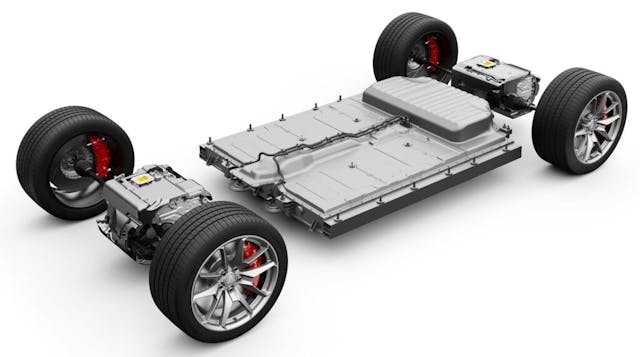
The initial run of Charger Daytona models will exclusively use a 400-volt system, but the forthcoming Banshee model—which the SRT Daytona Concept previewed—will employ the more powerful 800-volt system. All new Chargers will be built in Windsor, Ontario, Canada, with Samsung battery modules. They will initially be sourced from South Korea, though production is expected to move to the United States within a couple of years.
These same underpinnings will support six other new Stellantis vehicles under the Jeep, Alfa Romeo, and Maserati umbrellas.
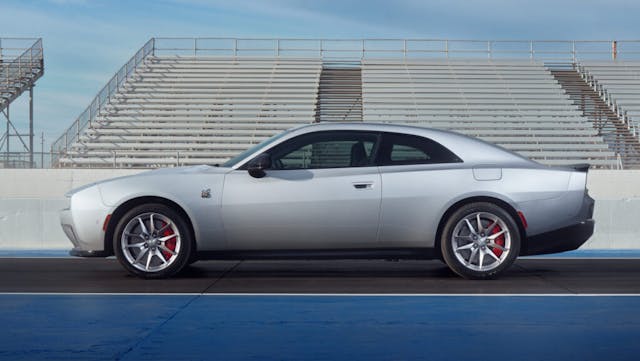
The overall footprint is 1.5 inches wider and a meaningful 8.7 inches longer than the outgoing Challenger Scat Pack Widebody, which means the new car is a sizable thing, indeed. Still, it doesn’t look ungainly. And Dodge designers did a remarkable job of integrating classic and modern design cues that both respect and evolve the outgoing design—arguably the most effective and enduring automotive design of the 21st century thus far. The full-width taillights, thick C-pillar, and squared-off front end read as recognizable Dodge cues, but with a futuristic treatment to replace the retro language. That the new car looks so good and also offers the utility of a liftback and a large trunk (22 cubic feet with the seats up, 33.3 with the rear seats folded) is a major achievement.

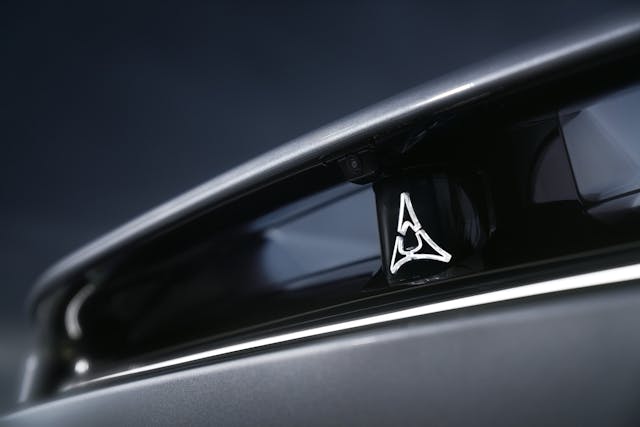
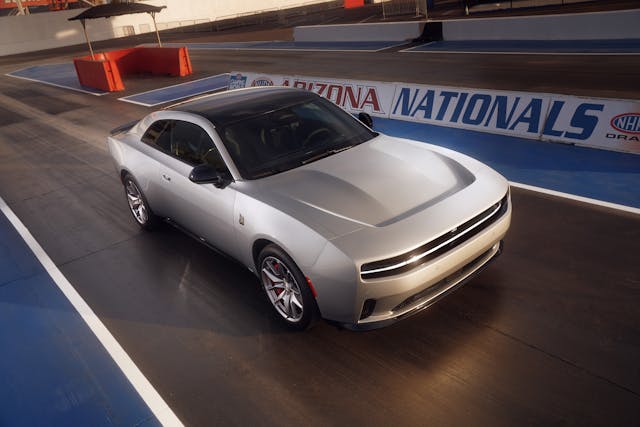
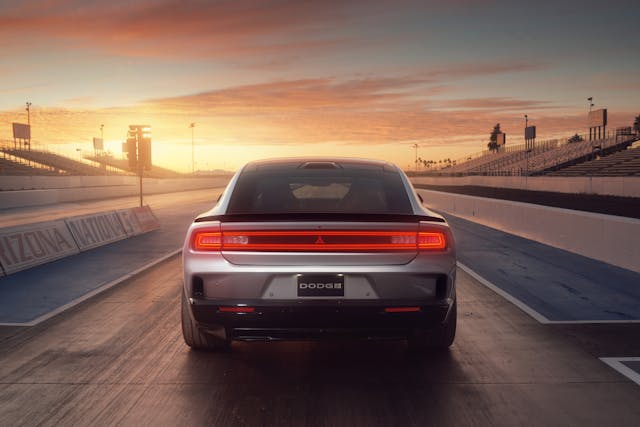
2024 Charger Daytona: Power, Suspension, Brakes
As expected, this new Charger will launch first with a pure-electric powertrain. That car, known as the Charger Daytona, will begin production in mid-2024 as a two-door coupe with a liftback-style rear hatch and seating for five.
Two models will appear at launch—the base R/T with 496 hp and the high-performance Scat Pack with 670. Max torque totals 404 lb-ft for the R/T and 627 for the Scat Pack. All-wheel drive is standard, courtesy of two identical electric drive modules (EDM), one for each axle, and independently capable of 250 kW (335 hp) and 314 lb-ft of torque. A standard mechanical limited-slip differential sits on the rear axle. Drivers will have the option to deactivate the front axle motor, enabling burnouts and donuts.
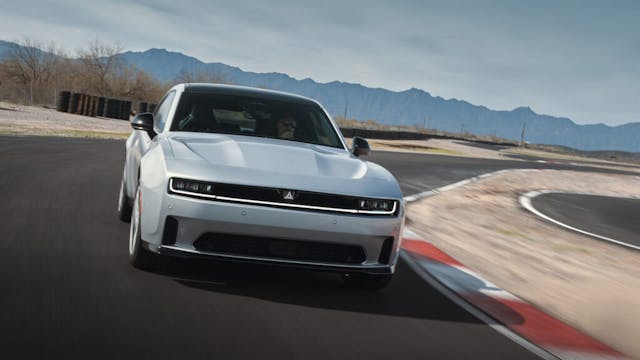
These initial Daytonas will come factory-equipped with Direct Connection upgrades. The standard Stage 1 kit for the R/T adds 40 hp (456 hp otherwise) and the standard Stage 2 kit for the Scat Pack adds 80 hp (590 hp otherwise). Later on, customers will need to buy these upgrade kits via Dodge’s Direct Connection performance catalog to unlock said power.
Drivers can experience maximum output from the twin electric motors but pushing the “Power Shot” button on the bottom right of the steering wheel. Power Shot adds 40 hp and lasts for 15 seconds, after which you’ll need to wait another 30 seconds to activate it again.
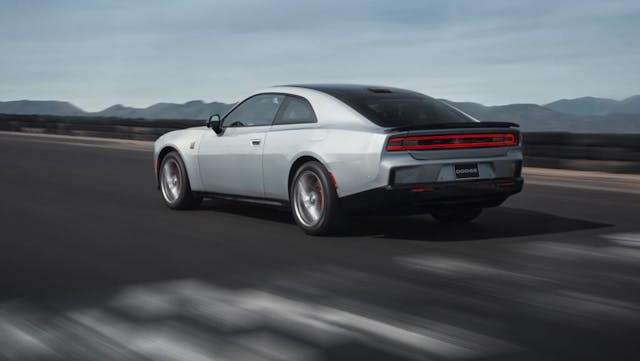
Dodge says the 0-to-60 sprint for the R/T Stage 1 model is over in 4.7 seconds, with a quarter-mile time of 13.1 seconds and a top speed of 137 mph. Scat Pack Charger Daytonas can do the same deeds in 3.3 and 11.5 seconds, on the way to a top speed of 134 mph.
2024 Charger Daytonas—both the R/T and Scat Pack—will also come with standard Track Pack stopping power: Brembo’s 16-inch, two-piece, vented front rotors with six-piston calipers and 16-inch, one-piece, vented rear rotors with four-piston calipers. Later Scat Pack models without the Track Pack will come with 15-inch brakes up front and 14s in the rear. Scat Pack Track Pack models feature 20-inch wheels and Dodge’s largest-ever tire package on a production model: Goodyear Eagle F1 Supercar 3s sized 305/35ZR20 up front and 325/35ZR20 out back.

All new Chargers come with multilink suspension all around. Daytona R/T models wear fixed monotube shocks, and Scat Pack models utilize the same setup with a higher spring rate. Those opting for the Track Pack version of the Scat Pack can expect dual-valve adaptive dampers on all four corners. Dodge was proud to point out that, compared with the outgoing Charger Scat Pack, there are three times as many accelerometers, four times as many ride height sensors, and four times as many wheel-hub accelerometers to monitor body position and handle various road conditions across all of the available drive modes.
Those drive modes include Auto, Eco, Sport, Wet/Snow, Track, and Drag (the last exclusive to Daytona Scat Pack). Within the Race Options menu there are a handful of special modes, such as Donut, Drift, Line Lock, and Launch Control. Race Prep mode sets an optimal battery temperature for the given conditions—cooler for road course lapping to allow the battery to heat up, and hotter for short bursts on drag strips.

2024 Charger Daytona: Battery, Range, Weight
Every Charger Daytona has a 100.5-kWh lithium-ion battery with a nickel-cobalt-aluminum chemistry. A big battery in a big coupe means a lot of weight: 5838 pounds for the R/T and Scat Pack alike. That is hundreds of pounds heavier than every starting weight for the 2025 Ram 1500, save the hybrid REV. For reference, the outgoing Challenger SXT tipped the scales at about 3800 pounds, while the Hellcat Redeye Jailbreak Widebody weighed 4445 pounds.
Kuniskis made a big to-do about how Dodge doesn’t care about range and instead optimized performance (because this is a MUSCLE CAR!), but buyers definitely care and want to know when they’ll run out of juice. The R/T Stage 1 is good for 317 miles of range and the Scat Pack Stage 2 for 260. Naturally, those figures will improve for future Daytona models without the standard Stage 1 or 2 kits.
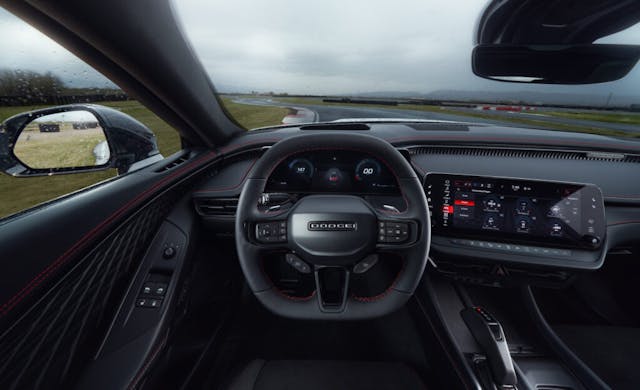
Using shift paddles on the steering wheel, drivers can adjust the regenerative braking force by selecting one of three levels.
Peak charging using a 350-kW DC fast charger is 183 kW, which can take the Daytona from 5 to 80 percent capacity in 32.5 minutes. Level 2 charging comes in at 11 kW. The standard plug is the CCS type, though Kuniskis hinted Dodge would soon reveal plans for an adapter that would permit access to Tesla’s Supercharger network.
Sixpack Power with Two or Four Doors
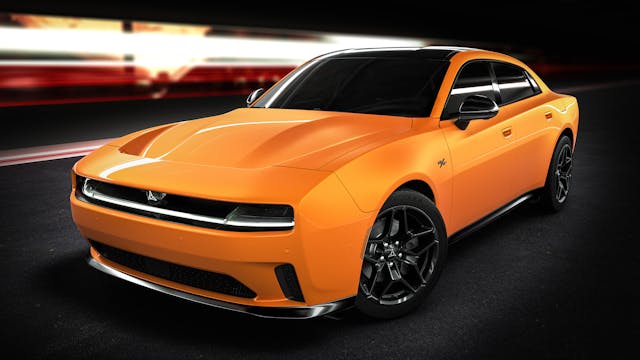
Combustion engine fans can rejoice, too. Prior rumors of a gas power proved true, and Dodge is calling this 3.0-liter Hurricane twin-turbo straight-six model the Charger Sixpack. When it joins the lineup early next year as a 2025 model, the Sixpack will also come in two states of tune: the base-model S.O. (Standard Output, 420 hp) and the high-performance H.O. (High Output, 550 hp). Every Sixpack comes with an eight-speed automatic transmission and all-wheel drive.
Kuniskis was adamant that the new Hurricane motor outperforms the old Hemi in every metric.

Sedans fans can rest easy knowing that the four-door Charger is back, also coming in early 2025, at the same time as the Sixpack. Four-door models will be available both in gas and electric form and the same output options as the two-door.
Slick as the two-door Charger looks, the four-door is even better. We only saw a design prototype, rather than a finished production model, but it has a powerful presence in person. It is somehow both imposing and impressive, though those attributes take nothing away from its elegance and sophistication. For my money, it’s the best-looking design out of Auburn Hills since the modern-era Chrysler 300.
2024 Dodge Charger: Interior and Infotainment
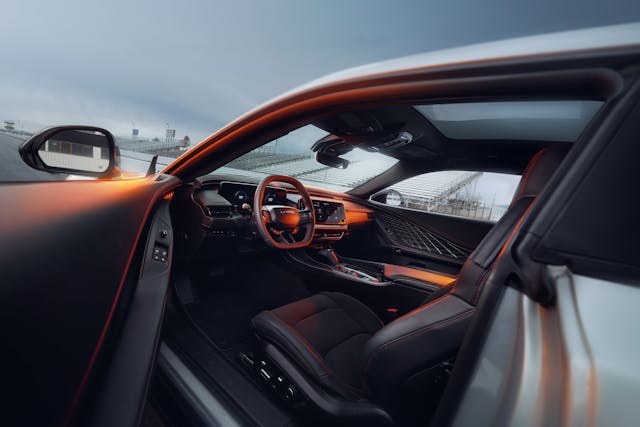
The new Charger’s interior is basically exactly what we saw on the SRT Daytona concept two years ago, minus the full-length center console and dual rear bucket seats. Fans of the vintage Charger may delight to hear that the vertical-slat pattern and texture on the instrument panel are meant to evoke the famous ’68 grille. Another classic touch is a new interpretation of the pistol-grip shifter. We’ll reserve final judgment once we can operate it for real, but after sitting in a very early production prototype at the reveal event, we can confirm it looks the business and feels good in the hand.
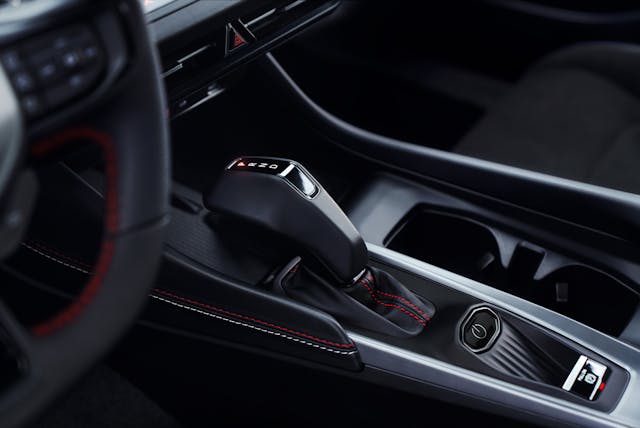
The steering wheel is big and fat, with a flat bottom and flat top that frames the optional 16-inch all-digital cluster. (A 10.25-inch screen is standard.) The center screen is a 12.3-inch unit showcasing the fifth generation of Stellantis Uconnect infotainment software. A row of physical buttons below the center display handles climate duties, and there is a knob for music/radio volume.
An electronic mechanism operates the doors of the 2024 Charger. There is a familiar external door handle, but inside the car you operate the mechanism via a button on the door. For those fearing being stuck inside the car with a dead battery, there is a redundant manual lever to disengage the latch that’s located on the bottom of the door card, near the footwell.
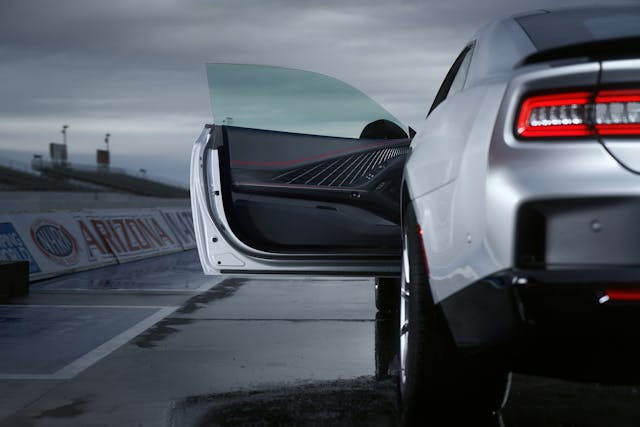
The materials in the top-trim, pre-production model (with Nappa leather) we sat in felt about on par with or a little better than those in the current Alfa Romeo Giulia and Stelvio. To be clear, that is a big, big step up from the interior of the outgoing Charger/Challenger. The cabin is not downright luxurious, but the feel is firmly in premium territory, and everything in sight looks fantastic. Our only complaint is that there is no way to fold the rear seats while standing behind the trunk opening—no automatic button or physical lever. Lowering the rear row requires reaching past the front bucket seat into the second row.
“Fratzonic” Chambered Exhaust
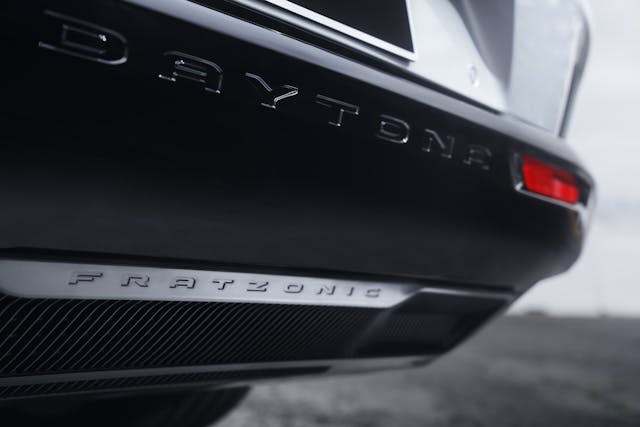
Perhaps the most controversial feature of the 2022 SRT Daytona Concept was the Fratzonic Chambered Exhaust. It’s an actual exhaust chamber that functions as a resonator for sound generated by speakers. The noise, Dodge says, will meet or exceed current Hellcat decibel levels and is engineered to mimic the cadence of a Hemi V-8.
We didn’t get to hear it at the Charger’s reveal event, a withholding which felt deliberate given the media’s unfavorable reaction to the initial sound back in 2022. Since then, Kuniskis said, the engineering team has worked through “hundreds” of iterations to get the sound just right. Chief Engineer Audrey Moore told Hagerty that for her it was the most fun part of the Charger project. (The toughest? Minimizing complexity and maximizing shared componentry between the two- and four-door Charger variants.)
The Charger Is Back, Baby
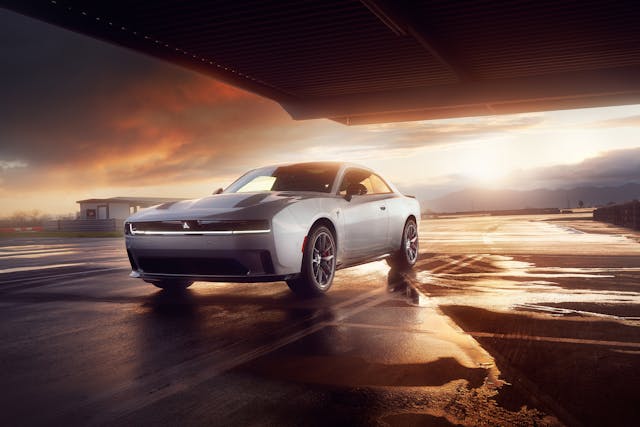
What the 2024 Charger will cost remains to be seen. Kuniskis told journalists that final pricing was still being enthusiastically debated at Dodge, so he refused to give even a shred of information on the subject. Given that all 2024 models will come with standard Track Pack brakes and Direct Connection kits, we expect a relatively high price compared with entry-level models that may trickle in down the road.
For now, it’s simply outstanding to see a new Charger coming our way. With the death of the Camaro, and the Mustang taking on more of a sports car role, Dodge has definitively cornered the market on the modern-day American muscle car. And, it seems wise at this juncture for Dodge to give people two avenues: dive in with both feet on an electric car or stick with a tried-and-true gasser. What’s more American, after all, than the power of choice?
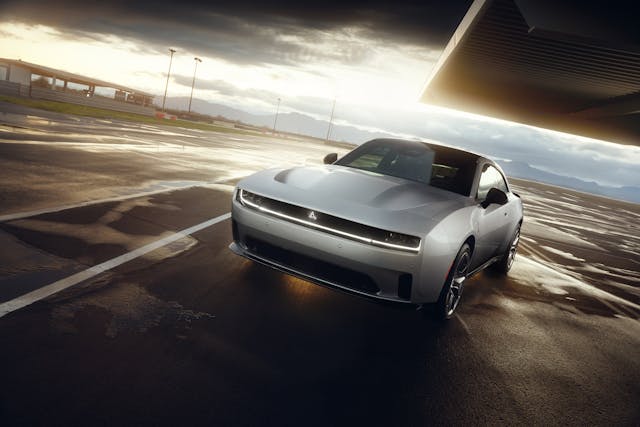
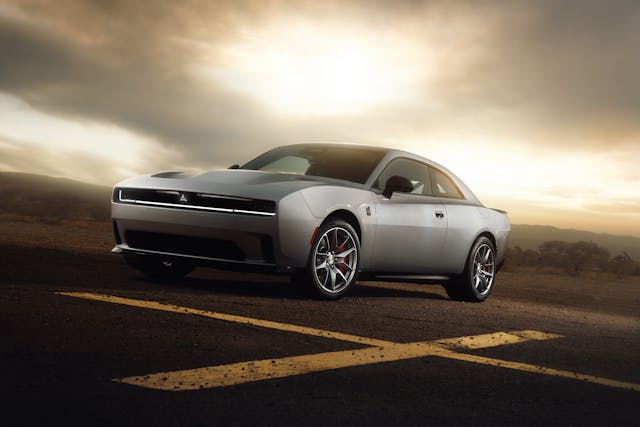
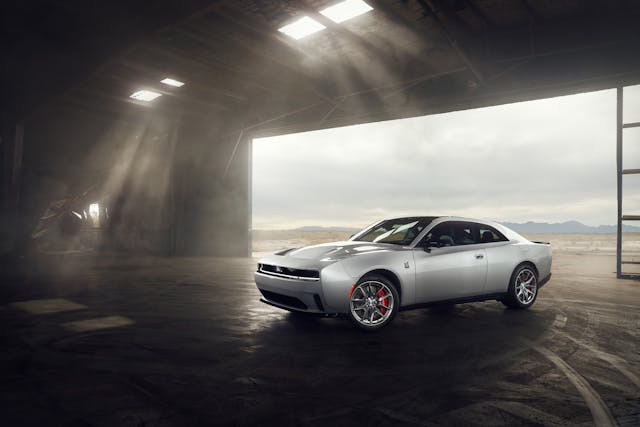
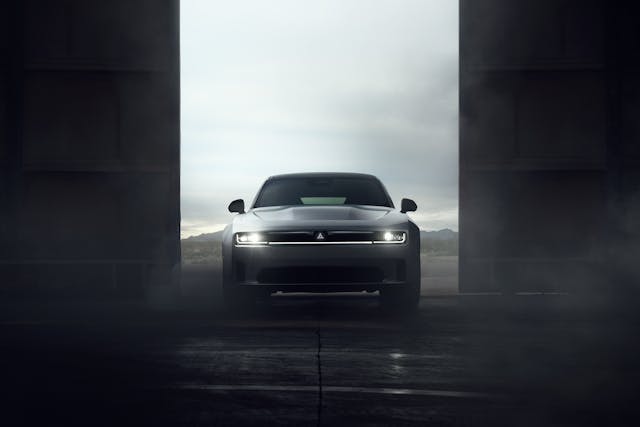
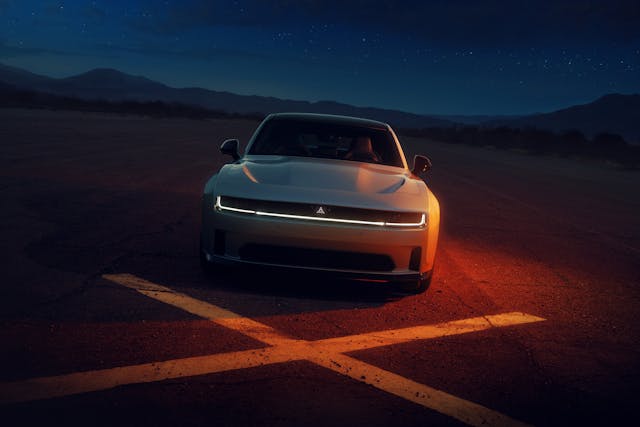

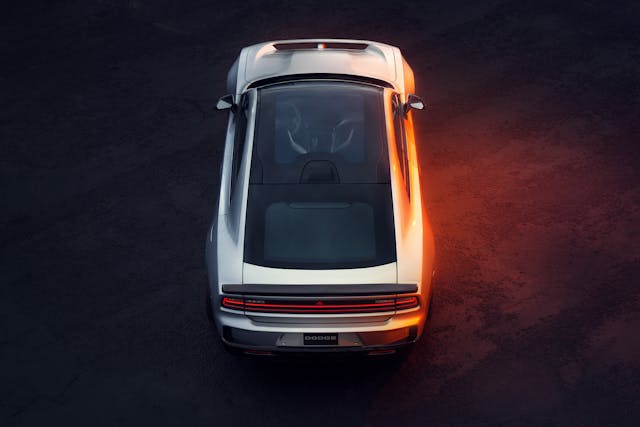
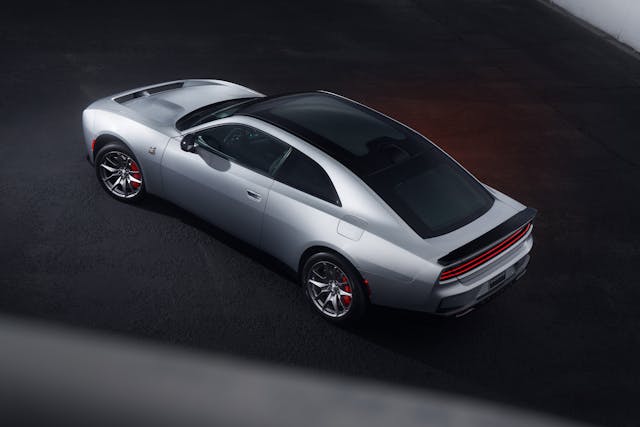
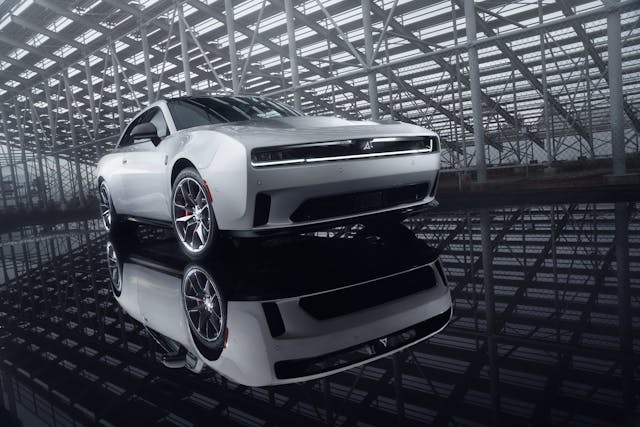


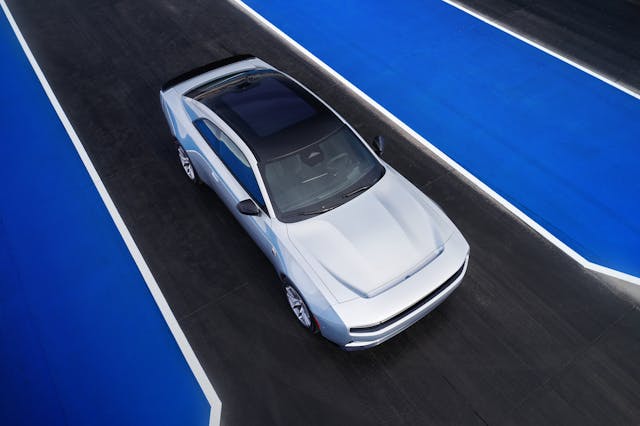

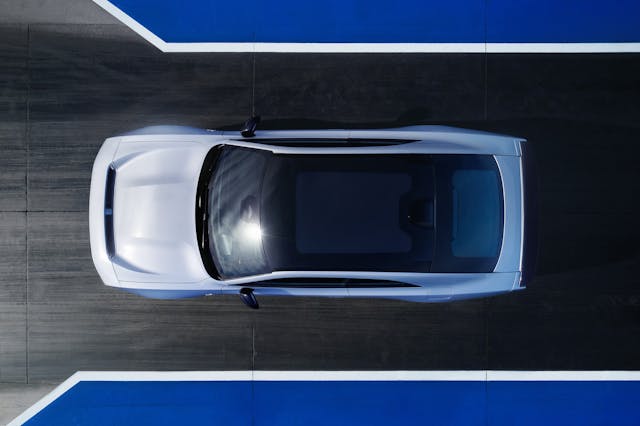
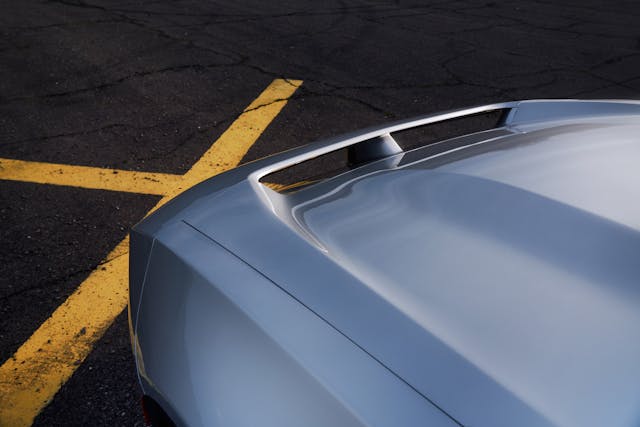
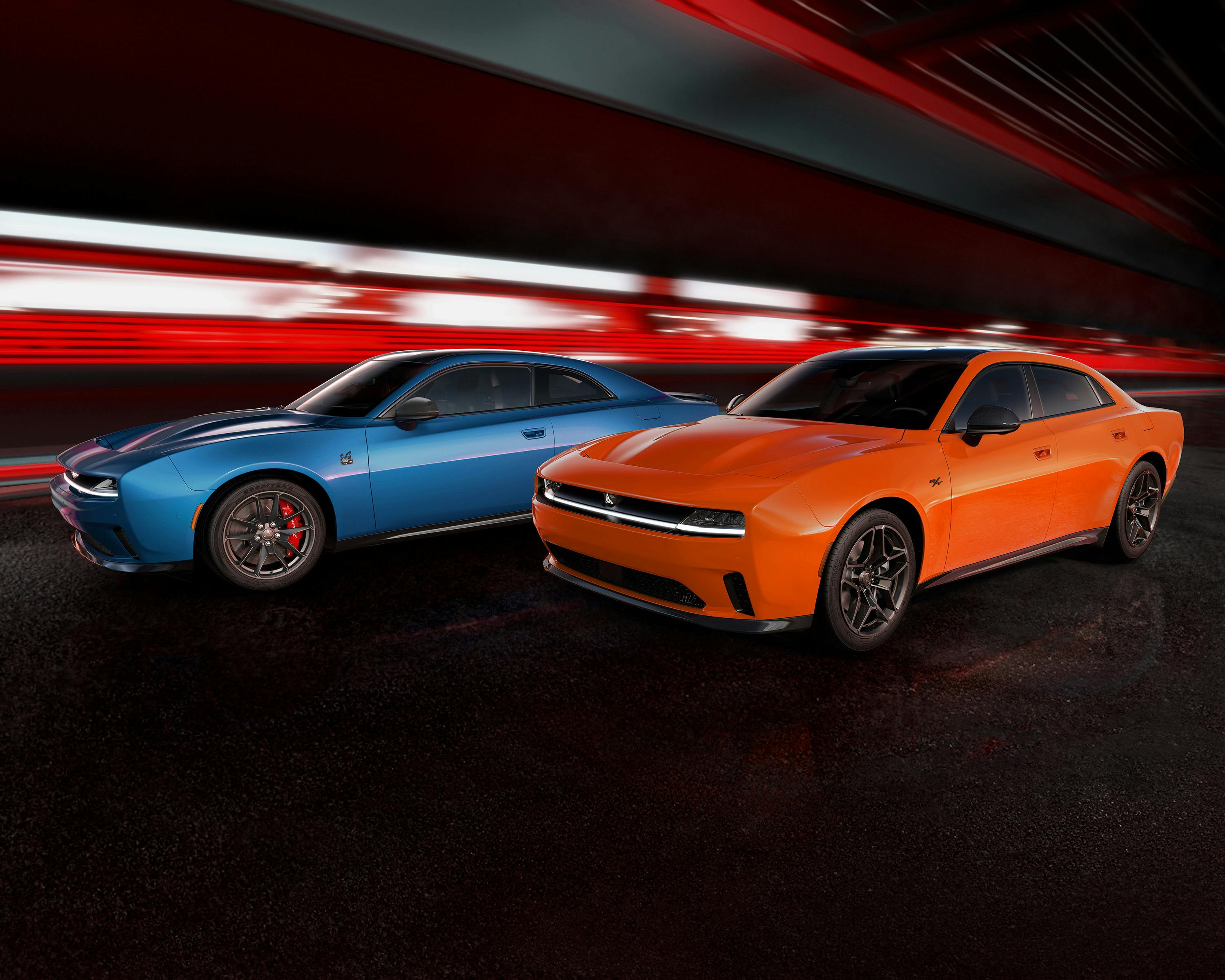
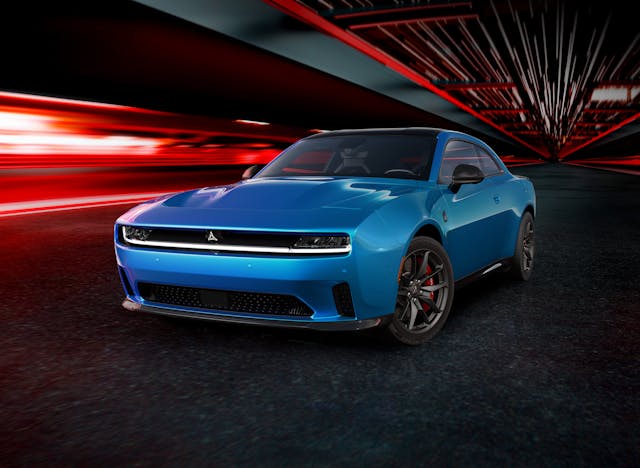

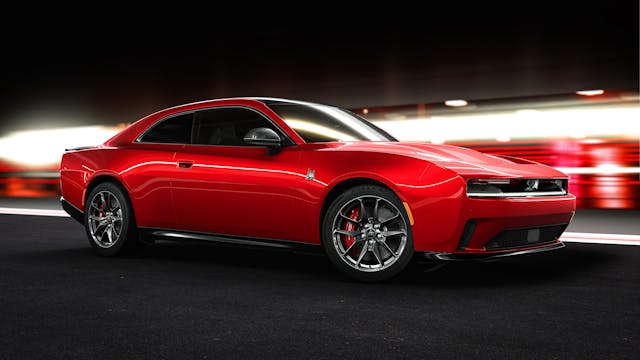
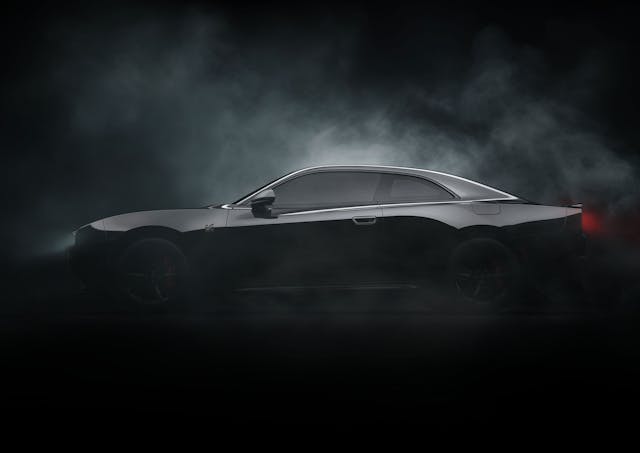
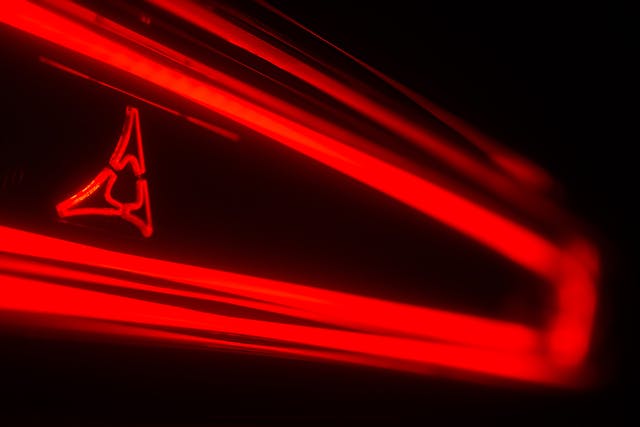
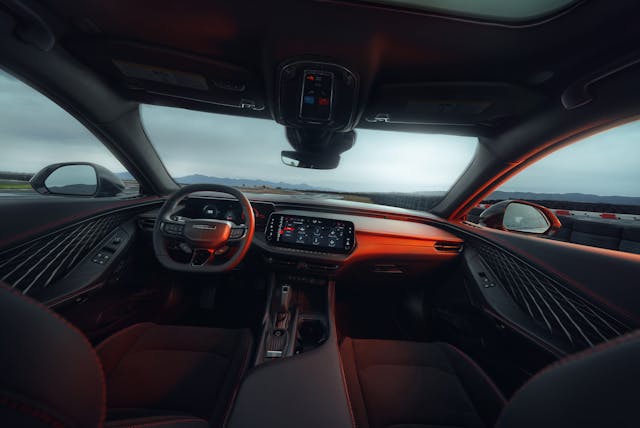



***
Check out the Hagerty Media homepage so you don’t miss a single story, or better yet, bookmark it. To get our best stories delivered right to your inbox, subscribe to our newsletters.
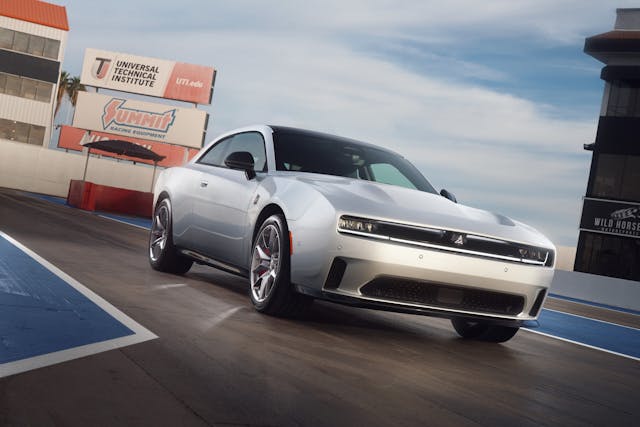


All wheel drive only is a miss I think.
Only way to accelerate like a Tesla.
This is the reaction to the CAFE and Carbon Mandates.
At some point they will mandate range. Especially with Stellantis/Dodge whatever saying they aren’t focusing on range.
The Nanny Karen fun sponges will get involved and mandate Trabants.
But even the inline 6 being AWD takes away that dodge playfulness
I assume there’s no standard 6 cylinder for everyday driving
That is one of the big pluses for the ICE models as vs. the ones just ended, in my opinion. If I never have to drive a RWD-only car in the snow again, I will be quite happy. Not to mention the better acceleration that AWD usually gives a powerful car.
V8? No
Three pedals? No
For me? Also no.
No for me also. My first Charger, a 1971 model had a 440 V8. I will not buy another Dodge that has no V8, I don’t care how much power the 6 makes. And I am sure not going to buy a hairdryer on wheels.
Good luck with that Stellantis.
Well, as long as you are not buying a new car, you might as well not buy a Dodge that gets to 60 in less than half the time that your old 440 did, while turning a quarter mile trap speed about 45mph faster.
I am a bit disappointed in the range, but this will improve over time. Of course, if you really figure it out, I doubt that the old 440 Dodge went further on a tank of gas.
All of the manufacturers are in the same boat, and most consumers will be buying EVs, or the occasional hybrid within a couple of years. If Stellantis can find about 60 or so miles, they may have very good luck, indeed.
Me… I am buying a hot, high performance V8 this year AND a hot high performance electric next year.
he says right before he slurps his tea with his pinky finger extended in the air…lol yeah enjoy your “hot high end performance V8 and EV” on the drive between your country club and your yacht. If only us plebs all had trust funds like you we would have “your” vision of the market.
My 69 charger 500 with a 440 magnum high performance 4 speed car got 5 miles to the gallon. But gas was 25 cents a gallon.
Two different drivetrains. One is a Muscle car, but no stick shift, so I’m out. The other is a high performance appliance. Sort of like replacing your 1/2 HP bench grinder to 3/4. Yawn
It looks very blah to me on the outside. I’m not impressed.
No V8 option? I feel it should have one but the top spec Hurricane model is fine. Still it’s no hellcat.
Fartsonic fake exhaust sound system for the EV’s? I see no point but enjoy faking having gas.
“Fartsonic” made me laugh, so thanks.
My first thought was I wonder if there is a speaker option available for behind the front grill that would makes sounds like a real Hemi, then I read about the speakers in the rear and had to chuckle out loud. I must admit that an Electric Car called the “Charger” had me chuckling out loud again. It’s a far-sight more interesting than the Mustang EV and I have beer a Mustang owner of several gas burners over the years and still own 2007 GT.
Too bad they didn’t mention anything about distance from start to stop, or how long the charging cable would need to be.
Somtime in the future I predict that there will be kits available to convert your EV to alternative fuels and be much cheaper than paying to replace two tons of batteries.
But I don’t expect to see any EV in my driveway at any time.
Think it is a marketing error bringing the electric version out first in the face of a for now shrinking EV market. Market could be soured on the vehicle by the time the gas version comes out. 5800 lbs??? Really? The four door sixpack could replace my lamented 300. Will it weigh five bills too?? Given Stellantis is pricing itself out of multiple segments (failing Hornet, Jeeps, Wagoneer looking at you) hope they don’t do it here too.
Weighing in at a ton more than the outgoing model and more than a 72 Eldorado…. how are roads going to handle all this weight…. tires are already wearing out faster according to recent reports. So… kids mining cadmium and lithium, destroying roads and fast tire wear……..and of course…. that Elektricity being generated by fossil fuels………..
Maybe they can use the Fartsonic exhaust as a wind farm and thereby be self-sustaining and energy independent. Who am I kidding, it’s all a shell game.
I recently read that parking garages will either have to reinforce their structures at great expense, or limit the number of EVs on each level in order to prevent them simply caving in under the higher weight. This comparison between last year’s Hemi and this year’s EV is illustrative.
Not as bad as it could have been (electric only), but not as good as it could have been either (no manual, AWD only, no V8). I can’t believe I’m saying this but the 4 door looks better than the 2 door. To me, the roof line on the 2 door looks bulbous and ungainly. The extra length of the 4 door mitigates that. Will withhold final judgement until I see one in person.
Can we finally get Dodge back in NASCAR now?
The only thing they failed to mention is that it probably weighs as much as a dump truck…
The story discusses weight, which for the Daytona is almost 6000 pounds. Woof.
They did not provide weight figures for the forthcoming Sixpack gas model.
10-4
Did they mention anything about the pricing of the gasoline vs EV versions? I might be wrong but I don’t think the EVs will make up more than 25% of Charger (and sure to follow Challenger) sales unless Chrysler puts a thumb on the scale and makes the gas version more expensive.
They outright refused to discuss pricing in any way, shape, or form.
Hallelujah’s! A coupe. I always thought the absence of a coupe made the last iteration of Charger a misfit. I’m an old drag racer who’s built dozens of hemis but find mega horsepower electrics exciting.
I love a large sedan. I don’t want something from Space Karen, so this fits the bill. This level of power without the gas bills interests me. It is also a very good looking EV, something few cars can be said to be.
…what is “Space Karen”? Have not heard of that before.
Keeping it family-friendly, this is a definite “Dodge this” to new auto scene.
-It’s clearly a Charger, has more original Charger DNA if you compare the roof to the 66 on the coupe (and Chargers need to be a coupe –at least as an option) though if you told me “kinda Marlin…” I won’t argue that.
-AWD makes this a good commuter in many markets. Makes it viable to me for example, vs. Subarus, really expensive things or crossovers.
-It says the FWD part of AWD can be shut off.
-Pricing will be extremely important.
-The EV is heavy… as are just about all EV. Is the 6 version as heavy?
-400+ horsepower does it really matter that it is a 6? Last era hemi’s don’t have hemispherical combustion chambers… so yeah, it’s too bad the Dodge LS engine is gone, but this 6 might really be something.
-Fake exhaust is always dumb.
To my eyes the 4 door looks better.
I can’t help but think the EV won’t sell particularly well. Dodge’s whole selling point for the Charger and Challenger has been pitching to hoons and Meatheads of all ages and income brackets. And since the EVs won the straight-line performance war (arguably the only war Dodge ever saw fit to fight) the only real thing the LX offerings had to actually offer was more noise and tire smoke. Why would I spend (probably) $60k on a nigh-on 3 ton sedan that doesn’t even make the vroom vroom noises Dodge lauds as their claim to fame when there are so many better EV options out there. It doesn’t Dodge enough compared to its predecessors and it doesn’t EV terribly well compared to its competition.
This car was needed 12 years ago with a V8. Too late too little.